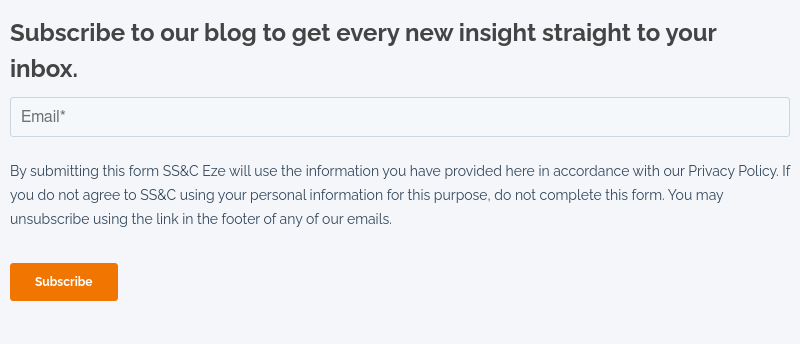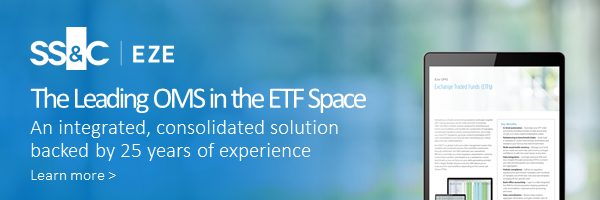The $8 trillion ETF market is growing at an annual rate of 26% and there is no sign of a slowdown anytime soon. Globally, ETF flows increased by 71% in 2021 to $1.22 trillion.
As the pace of investment continues to build, ETF managers face unprecedented challenges in navigating a complex and evolving regulatory landscape, and manual processes can be costly and time-consuming. For managers, having the right technology is necessary for success.

Here are just a few technology challenges that ETF managers face and some potential technological solutions:
Challenge: Manual ETF Order Flow and Processing of Creates and Redeems
ETFs regularly need to process creates and redeems alongside their accounts payable and this is often a manual process that places a burden on operations. In-kind redemptions offer investors leaving the fund payment using securities or other forms of property on a pro-rata basis rather than cash. But making in-kind redemptions and creations manually increases operations costs and takes valuable time away from alpha generation.
Solution: In-kind Automation
ETF managers require automation specific to the burst process of orders into in-kind or cash-in-lieu that the ETF issuer must trade. Implementing a scalable order management system capable of automating in-kind and cash-in-lieu ETF order processing on an intraday or daily basis, and flagging orders into their respective categories for handling can make it easy for ETF managers to distinguish in-kind and cash redeems, rebalance and conduct end-of-day interfacing.
Challenge: Labor Intensive Benchmark/Index Rebalancing
In order to effectively mirror indexes such as the S&P 500 and the Russell 5000 while providing similar after-tax returns, ETF managers need to know what the benchmark is and rebalance accordingly. As indices evolve, they need to be continuously monitored so exposure can be manually reduced or increased, which takes time away from generating alpha.
Solution: A Dynamic Platform that Allows You to Easily Load Standard or Custom Benchmarks & Indices and Monitor Comparisons in Real-time
Rather than make manual adjustments, using a dynamic platform that allows standard or custom benchmarks and indices to be loaded while enabling the monitoring of benchmark comparisons and rebalancing to an index or benchmark in real time can free up ETF managers time to focus on higher-value tasks.
Challenge: Disjointed Connectivity and Data
Connectivity to counterparties including custodians, administrators, brokers and authorized participants is table stakes for ETF managers. With this in mind, data centralization is crucial for developing a holistic view of a firm’s key data points and drawing the most actionable and accurate insights needed to maximize effectiveness.
Solution: Seamless Connectivity and Interoperability; Data Integration and Centralization
A system that employs a high degree of interoperability is a must for ETF managers. Having a real-time trading engine that seamlessly connects to executing brokers and ties directly into their algos, cash, or program desks, as well as the largest and most common ETF administrators has never been more important. The ability to centralize data onto a unified platform, aggregating and normalizing it across different counterparties and a solution that can communicate data back down stream as needed is a requirement in the current market.
ETF managers can benefit from a system that leverages an open, vendor-neutral architecture and prioritizes data integration, leveraging an extensive library of APIs and true, straight-through-processing to connect them with trade, security, and reference data, as well as custodians, fund administrators, key aggregators, benchmark providers, and other necessary third parties. Such a system enables more seamless workflows, making it easier to achieve best execution and improve operational alpha, while providing a better view of a firm’s standing and data to make actionable insights and improvements.
Challenge: Keeping Up with Evolving Investor Compliance Mandates
Investors’ mandates and regulatory requirements have changed dramatically over the past few years and their expectations of risk and compliance have evolved. Moreover, as ESG has become a focus for global investors, keeping up with changing regulatory and compliance standards manually has become more time consuming and difficult to manage. A lack of standardized rules and templates has compounded that difficulty, making it necessary to spend valuable time building them out.
Solution: Holistic & Out-of-the-box Compliance
A tool that allows ETF managers to check compliance across any aggregation, including security, asset class, portfolio, portfolio group, strategy and firm levels with pre-, intra-, and post-trade compliance can make managing complicated regulations across jurisdictions easier, while ensuring that they are adhering to ESG requirements, regulations and investor mandates.
ETF managers should ideally look for solutions that can also handle regulatory compliance, such as the 40 Act, in addition to exposure limits, limits versus a benchmark, and ESG-based compliance. A system featuring a variety of standard, preset rules and rule templates will further optimize compliance.
Challenge: Static Incumbent Technology and Service Not Built for You or to Grow With You
ETF managers should seek to incorporate an investment technology platform that is tailor-made for them right from the start and find the right partner and solution that can grow with them. Most order management providers are not flexible enough and do not have the workflows to handle ETFs. Whether that is not having true multi-asset class/multi-currency support, inflexible modeling/trade generation framework, non-configurable compliance, lack of integration/open architecture approach, call center support. As a result, many firms end up switching their systems entirely or spend time and money trying to customize their existing platforms or doing work in excel when they should be focusing on generating alpha.
Solution: Experience and Expertise with Firms like Yours & Flexible, Scalable Technology
Service and support are key concerns in a continuously evolving market. ETF managers should look for providers with years of experience working with firms that mirror their own and have a track record of stellar service, as well as the ability to offer additional assistance if needed. Having a provider that is always available to train and support a client is absolutely necessary given the software’s complexity. But, while availability should be a major factor in choosing a provider, it is also important that they are able to add value by advising clients on industry best practices implementing ETFs and operational workflows specific to their firm type.
ETF managers should make investing in a flexible, configurable, and scalable solution a priority, but not all of them are the same. For maximum benefit, a multi-asset, multi-currency platform that enables the management of funds across nearly any asset class and currency, and the addition of new asset classes amid growth or strategy changes is paramount. Additionally, the system should have the technical underpinnings to rapidly innovate, enhancing features and functionality, and the flexibility to be scalable as a firm grows.
Keeping these features in mind as you select your multi-asset class investment system can save you the cost and hassle of switching systems down the line.
Eze OMS is the leading OMS in the ETF space and offers cutting-edge workflows with connectivity to all the major and many boutique providers in the ETF space. As a global leader in the order management space, with 25 years of proven experience working in the ETF space and with funds of all shapes and sizes, Eze offers a consolidated solution covering trading, pre/intra/post trade compliance, allocations, modeling & rebalancing, cash management, audit trail, real-time analytics, tight integrations with all internal systems and third parties, and much more.
With 40 Act being native to our system, and integrated compliance built into our OMS – which runs on a pre, intra-, and post-trade basis – Eze is incredibly well fit to service the ETF space.
Eze’s sole focus is technology and support and we make a very significant investment in our platform and people. Of our 1000+ employees, we have about 80% dedicated to service/support and R&D, as well as the largest service team in the space.
The majority of OMS platforms exclusively cater to the hedge fund space and only deal with a few funds, but our best-in-breed platform can easily adapt to your business should you grow or add new funds. Eze allows you to scale your firm and workflows as managers look to continue to grow/add funds.
Eze’s platform is integrable with more than 750 third parties including brokers, networks, administrators, custodians, and most benchmark providers. Additionally, Eze OMS features native modeling and rebalancing functionality that is extremely flexible and configurable, as well as a powerful accounting engine, robust recon, and integration with all of your third parties.
Our expert service and implementation teams take a consultative approach to understanding your needs while advising on best practices we see in the space. Other competitors force you to think about things the way they do and lack the configurability or adaptability the ETF issuers require. We also offer a la carte options for clients who prefer them.
For more information, download the Eze OMS for Exchange Traded Funds (ETFs) overview.


